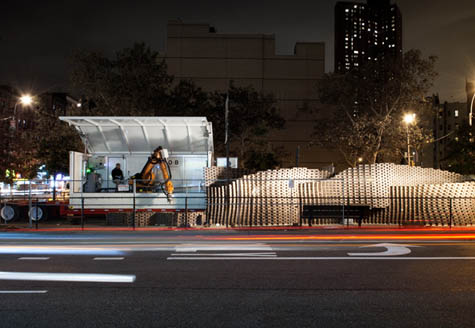 [Image: The Mobile Fabrication Unit by Gramazio & Kohler, soon to be building at Storefront for Art and Architecture].
[Image: The Mobile Fabrication Unit by Gramazio & Kohler, soon to be building at Storefront for Art and Architecture].
Some things to read on a Monday afternoon:
—Architect Bjarke Ingels of BIG dominates the stage at TED. I was able to walk around BIG’s recently completed Mountain Dwellings in Copenhagen the other week, as part of an amazing drive around what felt like all of Denmark with Johan Hybschmann and Nicola Twilley. The building’s now-famous parking garage, we suggested only half-jokingly, would make an amazing venue for an architecture conference: its terraced parking decks overlook and focus upon a kind of inadvertent auditorium. Drive-in films, drive-in lectures, drive-in pirate radio concerts – it’s too fantastic a space not to try.
—Lebbeus Woods offers a glimpse of a film he outlined, designed, and later co-wrote with Olive Brown, called Underground Berlin. It involves a disillusioned architect, a missing twin brother, neo-Nazi activities in the divided city, metallic underground tunnels connecting east to west, and “a top-secret underground research station rumored to be somewhere beneath the very center of Berlin.” There are even rogue planetary scientists investigating “the tremendous, limitless geological forces active in the earth.” Woods’s graphic presentation of the idea is incredible, and absolutely worth a very long look.
—Meanwhile, farmers in the UK have been asked “to implement measures which would reverse the UK-wide decline in skylark numbers.” This means shaving small rectangular plots into the midst of productive cropland, because “rectangular uncropped patches in cereal fields allow skylarks to forage when crops become too dense for them.” We will prepare our landscapes for other species.
—Is your iPod maxing out the U.S. electrical grid? Perhaps it doesn’t matter: New Scientist looks at how to short-circuit the grid altogether – and would-be saboteurs the world over are still taking furious notes. Alternatively, just follow the fantastic On The Grid series by Adam Ryder and Brian Rosa to see where the electrical network really goes.
—New Scientist also scanned beneath the south polar glaciers to find “Antarctica’s hidden plumbing” – and, as it happens, “the continent’s secret water network is far more dynamic than we thought.”
—Ruairi Glynn’s new book, Digital Architecture: Passages Through Hinterlands is now out; it documents Glynn’s related exhibition.
—Moving online, New York’s Architectural League has redesigned its website – joining the Canadian Centre for Architecture, who also redesigned their own site earlier this summer.
—Back in England, the BBC reports that pigs are being used “to help restore” parts of Worcestershire’s historic Wyre Forest. This comes at the same time that Cairo has realized that its absurd slaughter of every pig in the city last spring in order to guard against swine flu has led to an extraordinary garbage crisis. “The pigs used to eat tons of organic waste,” the New York Times reports. “Now the pigs are gone and the rotting food piles up on the streets of middle-class neighborhoods like Heliopolis and in the poor streets of communities like Imbaba.” Meanwhile, Edible Geography points our attention to the fascinating labyrinth of subsidiary products made from the bodies of dead pigs; welcome to “Pig Futures.”
—On io9 Matt Jones suggests that “the city is a battlesuit for surviving the future,” and he cites Archigram, Kevin Slavin, Dan Hill, Warren Ellis, the architecture of sci-fi, William Gibson, and much more to make his point. Speaking of Warren Ellis, Icon magazine recently published a long conversation between Warren, Francois Roche, and myself; you can check it out on Flickr.
—Were artificial hills, henges, and monumental earthworks a kind of “prehistoric sat nav” installed across the British landscape? And does this same question seem to be asked at least once every few years?
—The 2009 Solar Decathlon approaches.
—Gramazio & Kohler’s Mobile Fabrication Unit will arrive soon at New York’s Storefront for Art and Architecture. Between October 5 and October 27, it will be busy assembling “the first temporary public installation to be built on site by an industrial robot in New York.” Then, however, on Halloween, it will become possessed by incomprehensible forces from the Precambrian depths of the city, and, in a horrifying night of thunderous brickwork, it will wall off the island of Manhattan forever…

 [Image: From “
[Image: From “ [Image: From “
[Image: From “
 [Image: The architect and his construction robots by
[Image: The architect and his construction robots by  [Image: Courtesy of
[Image: Courtesy of  [Image: “Pike Loop” (2009) by
[Image: “Pike Loop” (2009) by  [Image:
[Image:  [Image: Greg Lynn’s
[Image: Greg Lynn’s  [Image:
[Image:  [Image: The
[Image: The